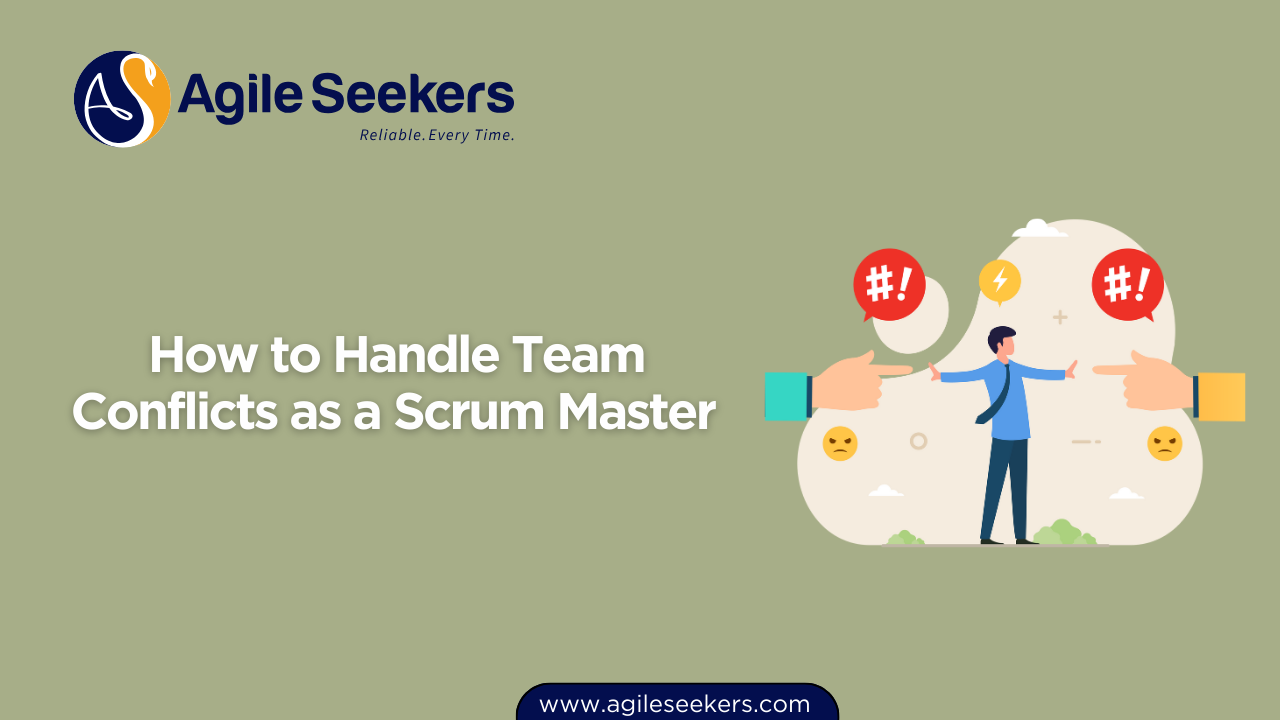How to Handle Team Conflicts as a Scrum Master

Conflict within Agile teams isn’t a sign of failure—it’s often a sign that people care. But unresolved conflict can hurt morale, delay delivery, and break trust. A Scrum Master plays a critical role in guiding teams through these tensions without taking sides. The goal is not to avoid conflict but to surface it early, facilitate resolution, and help the team grow from the experience.
Let’s break down how Scrum Masters can recognize, address, and learn from team conflicts using practical strategies aligned with Scrum values.
Why Conflicts Happen in Scrum Teams
Even high-performing Agile teams experience conflict. Common causes include:
-
Misaligned expectations between developers, Product Owners, and stakeholders
-
Ambiguity in roles or backlog items
-
Differences in personalities, communication styles, or values
-
Perceived favoritism or lack of contribution
-
Stress from deadlines or unclear priorities
Understanding the root cause is essential. As a Certified Scrum Master, you are not a mediator in the traditional sense—you are a servant leader who enables the team to resolve their own conflicts effectively.
Step-by-Step Guide: How to Handle Team Conflicts
1. Spot the Early Signs
Don’t wait for escalation. Subtle signs like silence during discussions, sarcastic remarks, avoidance behavior, or tension during standups are early indicators.
Tip: During retrospectives, use anonymous input tools or sticky notes to uncover hidden concerns.
2. Create Psychological Safety
Teams resolve conflict faster when they feel safe to speak openly without fear of judgment.
Scrum Masters foster this safety by:
-
Modeling respectful communication
-
Encouraging vulnerability without punishment
-
Making retrospectives a regular, constructive space
Google’s Project Aristotle emphasized psychological safety as the top trait of successful teams (source).
3. Listen Without Taking Sides
When team members bring up an issue, your first role is to listen. Resist the urge to “fix” the problem immediately. Instead:
-
Ask open-ended questions
-
Let both parties speak without interruption
-
Summarize what you heard to validate understanding
This neutral stance builds trust. It also reinforces your role as a facilitator—not a manager or judge.
4. Use Scrum Events Strategically
Each Scrum event is an opportunity to expose and address tension constructively.
| Scrum Event | How It Helps with Conflict |
|---|---|
| Sprint Planning | Clarifies roles, scope, and expectations |
| Daily Scrum | Surfaces blockers or interpersonal issues early |
| Sprint Review | Aligns team and stakeholders on product goals |
| Sprint Retrospective | Offers a safe space for team-driven conflict repair |
5. Facilitate Structured Conflict Conversations
When conflicts go unresolved, consider structured interventions like:
-
"Start/Stop/Continue" format during retrospectives
-
1-2-4-All Liberating Structures to surface shared views
-
Nonviolent Communication (NVC): Observe, Feel, Need, Request
Facilitate, don’t dictate. Help the team own their dialogue and decide on action steps.
6. Coach Individuals Privately When Needed
Sometimes, coaching in private is more appropriate—especially when conflict is personal or emotional.
Offer 1:1 sessions that focus on:
-
Encouraging empathy
-
Offering tools for effective communication
-
Reflecting on behavior and its impact
This personalized support reinforces your role as a CSM coach and servant leader, not a command-and-control figure.
Tools That Can Help
Some tools support healthy discussions and structured facilitation:
| Tool/Technique | Use Case |
|---|---|
| Confluence or Miro | Documenting and visualizing team agreements |
| FunRetro or Parabol | Anonymous input during retrospectives |
| Conflict Mode Instrument | Helps team members understand their conflict style |
| Dot Voting | Prioritizing concerns collaboratively |
Pitfalls Scrum Masters Should Avoid
Avoiding these common traps ensures your intervention helps rather than hinders:
| Common Pitfall | Why It Fails |
|---|---|
| Taking sides | Destroys neutrality and breaks team trust |
| Suppressing conflict | Delays resolution and often worsens resentment |
| Blaming individuals | Leads to shame instead of growth |
| Skipping retrospectives | Misses key opportunities for repair and reflection |
Promote Conflict as a Growth Opportunity
A mature team sees conflict as a path to clarity—not something to fear. As a Scrum Master, your job is to guide them toward that maturity. Create a learning environment where mistakes lead to better agreements and where friction improves collaboration.
Scrum thrives on transparency, inspection, and adaptation—conflict is often a signal that one of these pillars needs attention.
Continue Strengthening Your Conflict Facilitation Skills
Handling team conflict is not a one-time skill—it evolves. Formal CSM training provides frameworks, techniques, and real-world scenarios to help Scrum Masters grow in this area.
If you’re just starting or looking to advance your facilitation capabilities, a CSM certification equips you with practical tools that go beyond theory.
For a deeper dive into conflict resolution techniques, the International Association for Conflict Management (IACM) offers excellent research and best practices for facilitators and coaches.
Final Thoughts
Conflict isn’t the enemy—mismanaged conflict is. As a Scrum Master, your influence can turn heated debates into constructive conversations, transforming tension into team alignment. Equip your team with the space, tools, and mindset to grow through conflict. That’s where real agility begins.
Also read - Servant Leadership in Action: Real-World Practices for Scrum Masters
Also see - How Scrum Masters Support Flow Efficiency in Agile Teams




















